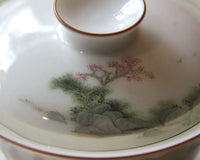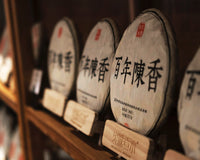What do people mean when they talk about ancient tea trees? Generally speaking, Ancient Tea Trees (gu shu 古树) are defined as tea plants aged 100 years and above.*
The term 'Ancient Tea Tree' primarily relates to trees grown in Yunnan from which the leaf is used to produce Puerh tea, and sometimes white tea and black tea.
In other regions, older and ancient tea bushes are referred to as Lao Cong 老丛 or 老枞.
Teas made using leaf from Ancient Tea trees command much higher prices and are in high demand. In China, the prevalence of Ancient Tea Tree Puerh seems to be increasing, yet the production output of ancient tea trees is far from prolific. Some advocate only two picks per tree per year at most, as over-picking is detrimental to both the tree and the subsequent quality of the leaf and tea.
In fact, it is very difficult to establish a precise age for any tree; it is either determined by local hearsay or by sellers (generously) estimating from the size and thickness of the tree trunk. As you can imagine, both methods lack objectivity and are prone to exaggeration.
Furthermore, surely there isn't much difference between a 90 year old and 100 year old tea tree? Might this be hype designed to ratchet up the cost of Puerh tea?
.jpg)
A historical explanation for the distinction of "ancient" tea trees - trees aged over 100 years - is that large-scale planting of tea plants occurred between the years 1820-1850 and again at the very beginning of the Chinese Republic (1912). Surviving trees from this period, as well as those in existence before these two phases, are distinct from those tea plants grown in the modern era.
Mass propagation of tea plants from these existing tea trees, using modern cutting techniques, only began in the mid-1980s. Therefore, Ancient Tea Trees are those trees remaining from the aforementioned large-scale planting that took place both at the beginning of the 19th and 20th century and any trees pre-dating these two periods.
* Another view is that genuine Ancient Tea Tree age should be defined as 300 years and above. And that tea trees between the ages of 100 - 300 should only be referred to as 'Large Trees'.











